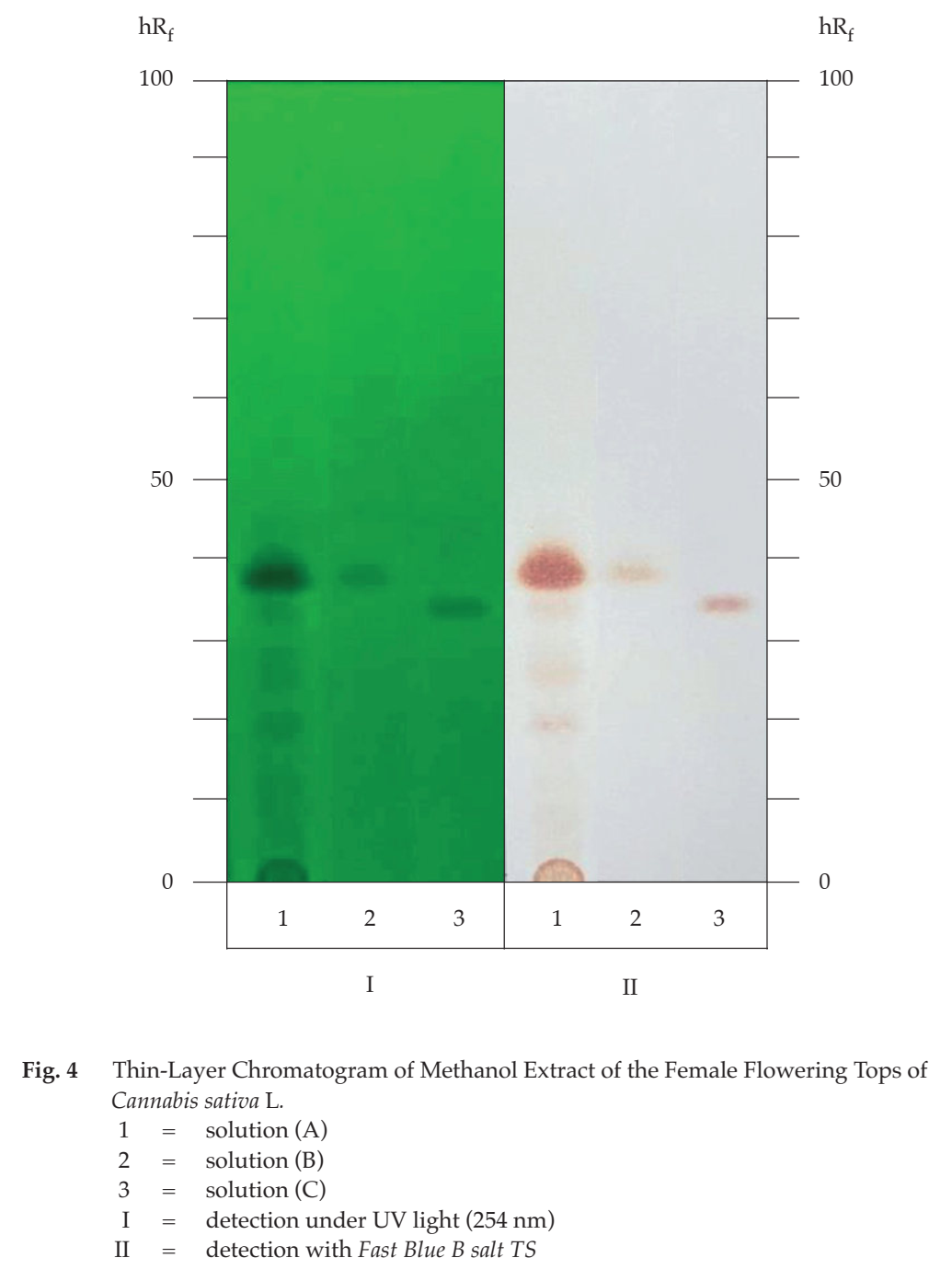ตำรามาตรฐานยาสมุนไพรไทย
Thai Herbal Pharmacopoeia
สำนักยาและวัตถุเสพติด กรมวิทยาศาสตร์การแพทย์ กระทรวงสาธารณสุข
Bureau of Drug and Narcotic, Department of Medical Sciences, Ministry of Public Health(Tinospora crispa (L.) Hook.f. & Thomson)
(Nelumbo nucifera Gaertn.)
(Centella asiatica (L.) Urb.)
(Centella Dry Extract)
(Centella Cream)
(Mesua ferrea L.)
(Piper sarmentosum Roxb.)
(Piper sarmentosum Roxb.)
(Pterocarpus santalinus L. f.)
(Santalum album L.)
(Senna tora (L.) Roxb.)
(Senna alata (L.) Roxb.)
(Senna Alata Tea)
(Piper retrofractum Vahl)
(Myristica fragrans Houtt)
(Andrographis paniculata (Burm. f.) Nees)
(Andrographis Capsules)
(Allium ascalonicum L.)
(Ocimum tenuiflorum L.)
(Curcuma longa L.)
(Turmeric Capsules)
(Turmeric Dry Extract)
(Turmeric Dry Extract Capsules)
(Arcangelisia flava (L.) Merr.)
(Curcuma sp.)
Harrisonia perforata (Blanco) Merr.
(Aristolochia pierrei Lecomte)
(Zingiber officinale Roscoe)
(Ginger Capsules)
(Ginger Tea)
(Cassia fistula L.)
(Nardostachys jatamansi (D. Don) DC.)
(Angelica sinensis (Oliv.) Diels)
Artemisia annua L.
(Ligusticum sinense Oliv. cv. Chuanxiong)
(Neopicrorhiza scrophulariiflora Pennell)
(Atractylodes lancea (Thunb.) DC.)
(Aucklandia lappa Decne)
(Terminalia chebula Retz.)
(Angelica dahurica (Hoffm.) Benth. & Hook. f. ex Franch. & Sav. var. dahurica)
(Kaempferia parviflora Wall. ex Baker)
(Hibiscus sabdariffa L.)
(Roselle Tea)
(Allium sativum L.)
(Zingiber zerumbet (L.) Sm.)
(Wurfbainia testacea (Ridl.) Škorničk.& A. D. Poulsen)
(Cannabis sativa L.)
(Myristica fragrans Houtt)
(Dracaena cochinchinensis (Lour.) S. C. Chen)
(Ficus racemosa L.)
(Hyptis suaveolens (L.) Poit.)
Clerodendrum indicum (L.) Kuntze
(Phyllanthus emblica L.)
(Citrus hystrix DC.)
(Citrus hystrix DC.)
(Areca catechu L.)
(Momordica charantia L.)
Moringa oleifera Lam.
(Aegle marmelos (L.) Corrêa)
(Solanum trilobatum L.)
(Morus alba L.)
Gynostemma pentaphyllum(Thunb.)
Makino
(Clinacanthus nutans (Burm. f.) Lindau)
(Cissus quadrangularis L.)
(Mimusops elengi L.)
(Zingiber montanum (J. König) Link. ex A. Dietr.)
(Piper betle L.)
(Capsicum annuum L.)
(Capsicum Oleoresin)
(Capsicum Gel)
(Piper nigrum L.)
(Piper nigrum L.)
(Eurycoma longifolia Jack)
(Thunbergia laurifolia Lindl.)
(Piper wallichii (Miq.) Hand.-Mazz.)
Senna garrettiana (Craib) H. S. Irwin & Barneby
(Terminalia bellirica (Gaertn.) Roxb.)
(Terminalia chebula Retz.)
(Caesalpinia bonduc (L.) H. Roxb.)
(Tarlmounia elliptica (DC.) H. Rob., S. C. Keeley, Skvaria & R. Chan)
(Hog Creeper Vine Dry Extract Capsiles)
(Hog Creeper Vine Dry Extract)
(Brachypterum scandens (Roxb.) Miq.)
(Lepidium sativum L.)
(Nigella sativa L.)
(Cuminum cyminum L.)
(Foeniculum vulgare Mill.)
(Plantago ovata Forssk.)
(Pimpinella anisum L.)
(Carum carvi L.)
(Anethum graveolens L.)
(Trachyspermum ammi (L.) Sprague)
Albizia procera (Roxb.) Benth.
(Acorus calamus L.)
(Tiliacora triandra (Colebr.) Diels)
Cyanthillium cinereum (L.) H. Rob.
(Orthosiphon aristatus (Blume) Miq.)
Murdannia loriformis (Hassk.) R. S. Rao & Kammathy
(Capparis micracantha DC.)
(Chrysopogon zizanioides (L.) Roberty)
(Cyperus rotundus L.)
(Cannabis sativa L.)
(Syzygium aromaticum (L.) Merr. & L. M. Perry)
(Boesenbergia rotunda (L.) Mansf.)
(Acanthus ebracteatus Vahl)
(Acanthus ilicifolius L.)
(Kaempferia galanga L.)
(Curcuma comosa Roxb.)
Betula alnoides Buch.-Ham. ex D. Don
Cannabis sativa L.
Carthamus tinctorius L
Mitragyna speciosa (Korth.) Havil
Mallotus repandus (Rottler) Müll. Arg
Azadirachta indica A. Juss. var. siamensis Valeton
Azadirachta indica A. Juss. var. siamensis Valeton
Punica granatum L.
Rhinacanthus nasutus (L.) Kurz
Baliospermum solanifolium (Burm.) Suresh
Curcuma aeruginosa Roxb
Boesenbergia kingii Mood & L. M. Prince
Senegalia rugata (Lam.) Britton & Rose
Acacia concinna (Willd.) DC.
Senegalia rugata (Lam.) Britton & Rose
Acacia concinna (Willd.) DC.
Senna alexandriana Mill. var. alexandriana
Cassia acutifolia Delile, Cassia angustifolia Vahl
Butea superba Roxb. ex Willd.
[Plaso superba (Roxb. ex Willd.) Kuntze, Rudolphia superba (Roxb. ex Willd.) Poir.
Pueraria candollei Graham
ex Benth. var. mirifica (Airy Shaw & Suvat.) Niyomdham
Streblus asper Lour.
Suregada multiflora (A. Juss.) Baill. (Gelonium
multiflorum A. Juss.
Category Source of cannabidiol.
Hemp Female Flower is the dried female flowering top of Cannabis sativa L. [C. indica Lam., C. ruderalis Janisch., C. ruderalis (Janisch.) S. Z. Liou, C. sativa L. subsp. indica (Lam.)
E. Small & Cronquist, C. sativa L. var. indica (Lam.) Wehmer] (Family Cannabaceae), Herbarium Specimen Number: DMSC 5340, Crude Drug Number: DMSc 1219.
Constituents Hemp Female Flower contains cannabinoids (e.g., cannabidiol or CBD, Δ9-tetrahydrocannabinol or Δ9-THC or THC). It also contains monoterpenes (e.g., d-limonene, β-myrcene, α-pinene, and γ-terpinolene), sesquiterpenes (e.g., β-caryophyllene, and
α-humulene), etc.
Description of the plant (Fig. 1) Herbaceous plant, dioecious, occasionally monoecious, at least 2 m tall and up; stem and branches angular, erect, covered with rather short stiff hairs. Leaves palmately compound or reduced to simple, opposite near base, spirally arranged upwards; petiole up to 10 cm long, pubescent; stipule erect, linear or narrowly subulate, 4 to 6 mm long, persistent; leaflets (3‒)5 to 11, narrowly lanceolate, linear to linear-lanceolate, 2 to 15 cm long, 0.2 to 2 cm wide, apex acuminate-caudate, base narrowly cuneate, margin coarsely serrate, upper surface dark green, scabrous, lower surface whitish green with scattered brownish resinous dots, densely pubescent with appressed hairs, nerves 8 to 20 pairs; sessile. Flowering top numerous inflorescences, terminal or axillary; male inflorescence diffused and paniculate, bracts small; female inflorescence axillary and terminal, 1 to 5 cm long. Flower small, unisexual; male flower: yellowish green; tepals 5, free, elliptic or oblong, 3 to 5 mm long, 1.5 to 2 mm wide, apex acute, margin entire, finely pubescent; stamens 5, opposite tepals, filament slender, 0.5 to 1 mm long, anther basifixed, oblong, 2-celled, dehiscing by apical pore; female flower: greenish, subsessile, enveloped by perigonal bract, membranous spathe-like, dark green, with glandular hairs; tepals fused into thin-textured tube adnate to ovary, in some cultivars, merely a ring at base of ovary; ovary superior, subglobose, 1 to 2 mm in diameter, 1-loculed, style short divided into 2 stigmatic slender arms, brown, pubescent, caducous. Fruit an achene, ovoid or ellipsoid, 2 to 5 mm long, 3 to 4 mm wide, somewhat compressed, minutely pilose to glabrous, yellowish brown to white or greenish, mottled with purple pericarp crustaceous, finely reticulate. Seed 1, shiny.
Description Odour, slightly tea-like; taste, bland or slightly bitter.
Macroscopical (Fig. 1) Hemp Female Flower occurs as flowering stem with sugar leaves, and female inflorescences, olive green to brownish. Flowering stem, angular, covered with rather short hairs. Sugar leaves, usually reduced to simple. Female inflorescence, axillary and terminal, 1 to 5 cm long; female flower, enveloped by perigonal bract, membranous spathe-like, dark green. Fruit an achene, ovoid or ellipsoid, with 1 shiny seed.
Microscopical (Figs. 2a‒2f) Transverse section of the reduced leaf of the female flowering top through the midrib shows upper epidermis, mesophyll, vascular tissue, and lower epidermis. Upper epidermis: a layer of rectangular cells, covered with cuticle layer; unicellular trichomes, some containing cystolith; multicellular glandular trichomes with short stalk; multicellular multiseriate glandular trichomes. Mesophyll: 1 or 2 layers of cylindrical palisade cells, some containing rosette aggregate crystals; spongy cells, irregularly shaped, loosely arranged; and parenchyma, some containing rosette aggregate crystals. Vascular tissue: phloem and xylem, scattering in the mesophyll. Lower epidermis: a layer of rectangular cells, covered with cuticle layer; raised stomata; unicellular trichomes, some containing cystolith; and multicellular multiseriate glandular trichomes.
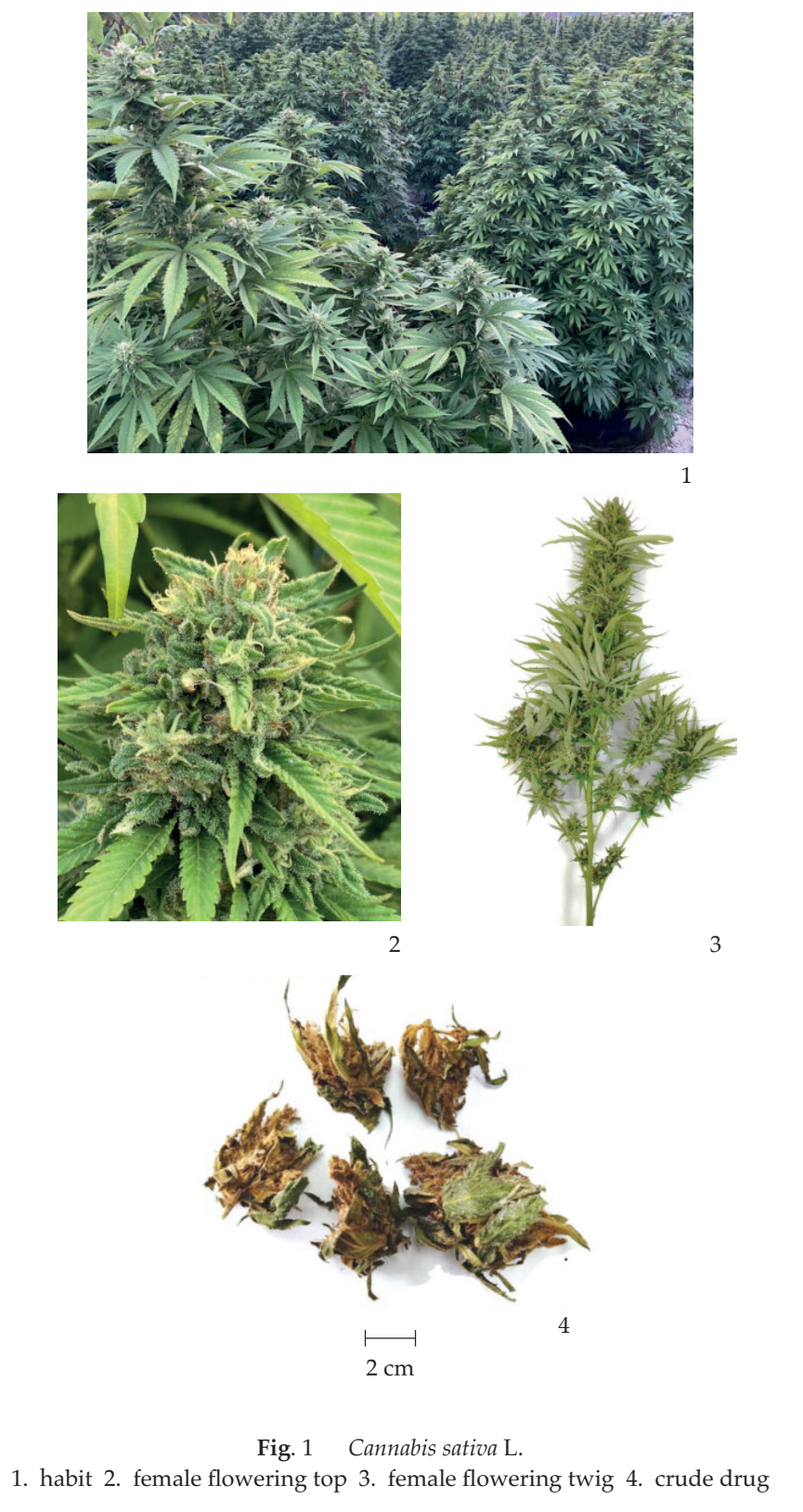
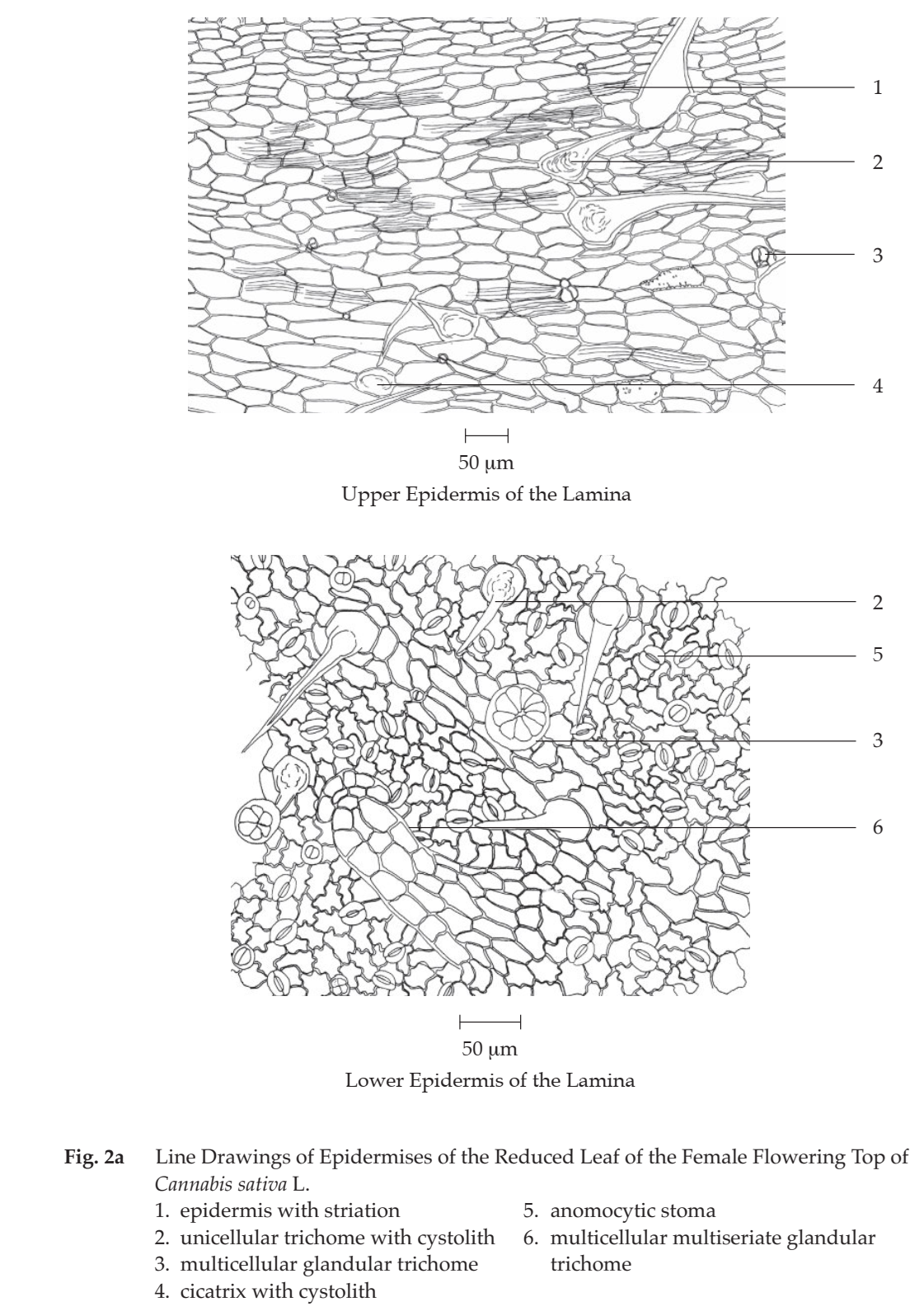
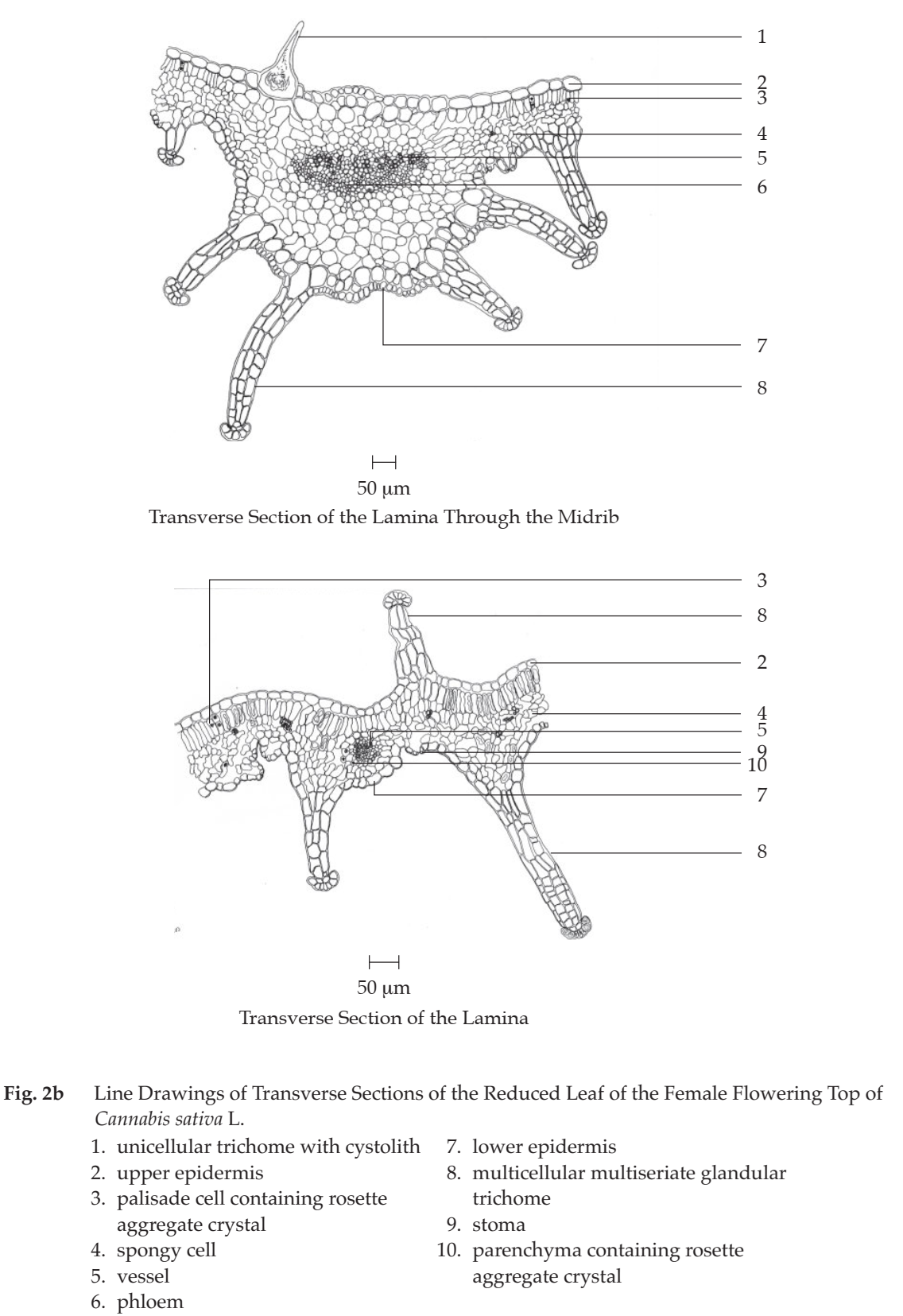
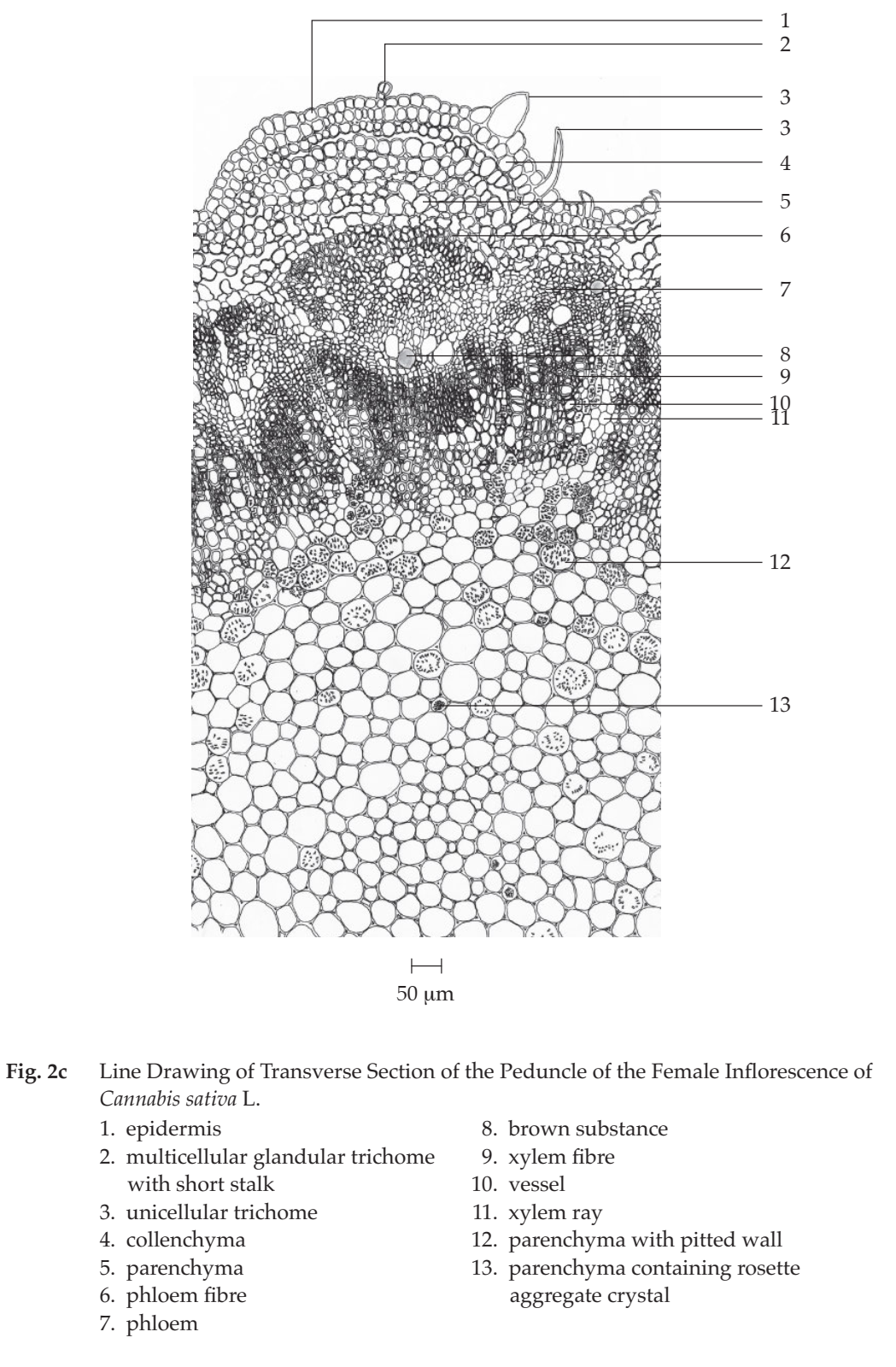
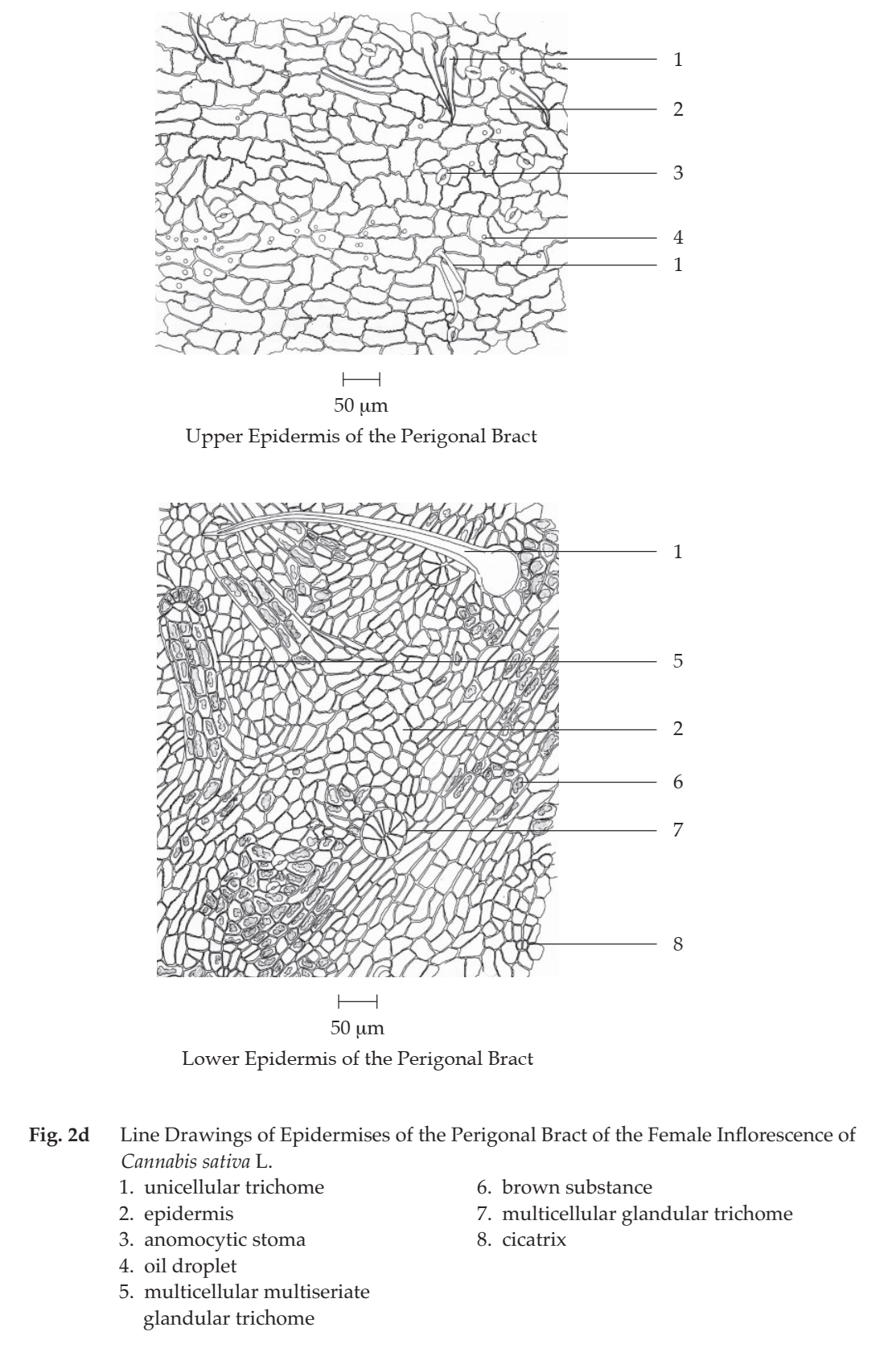
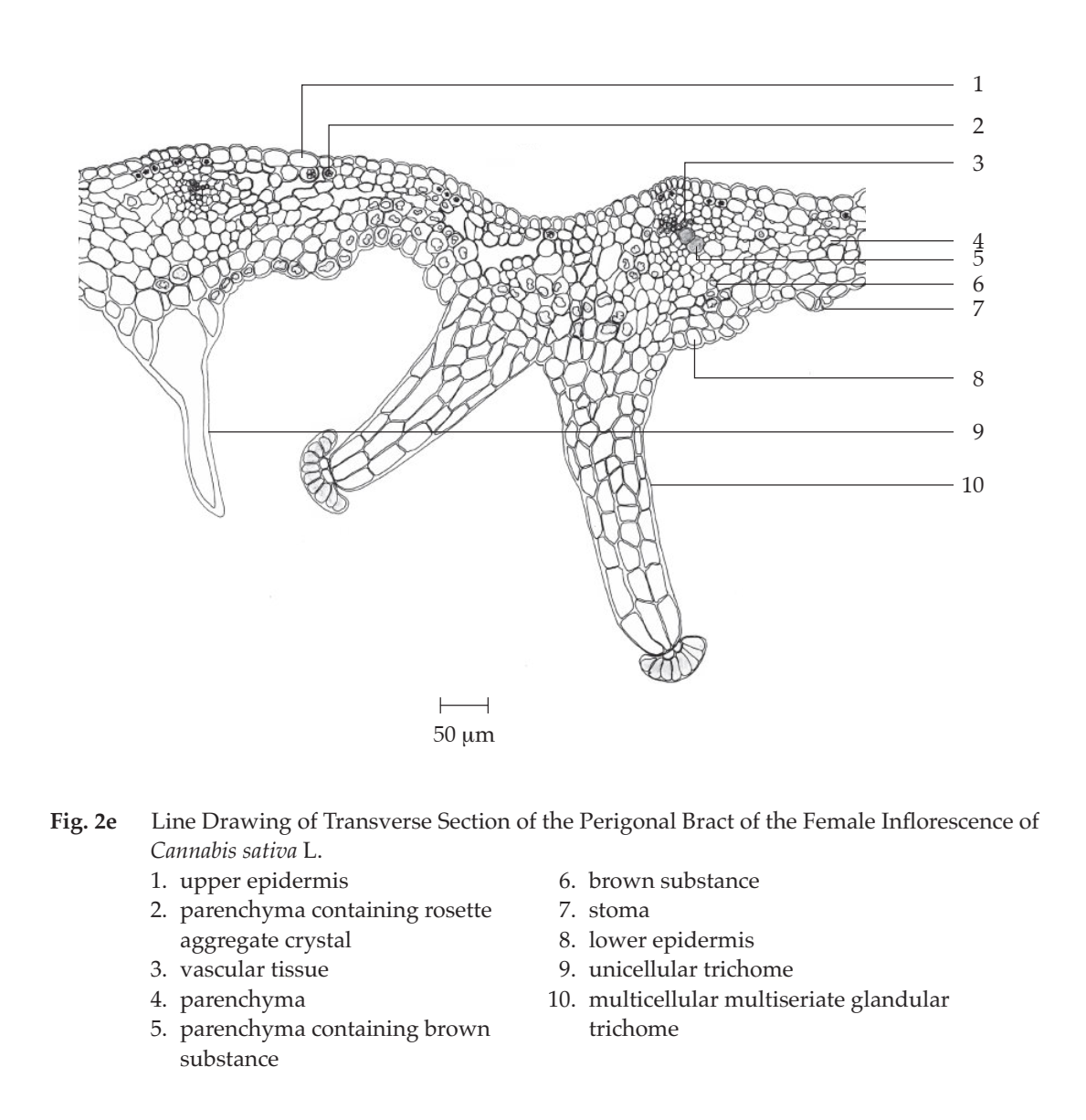
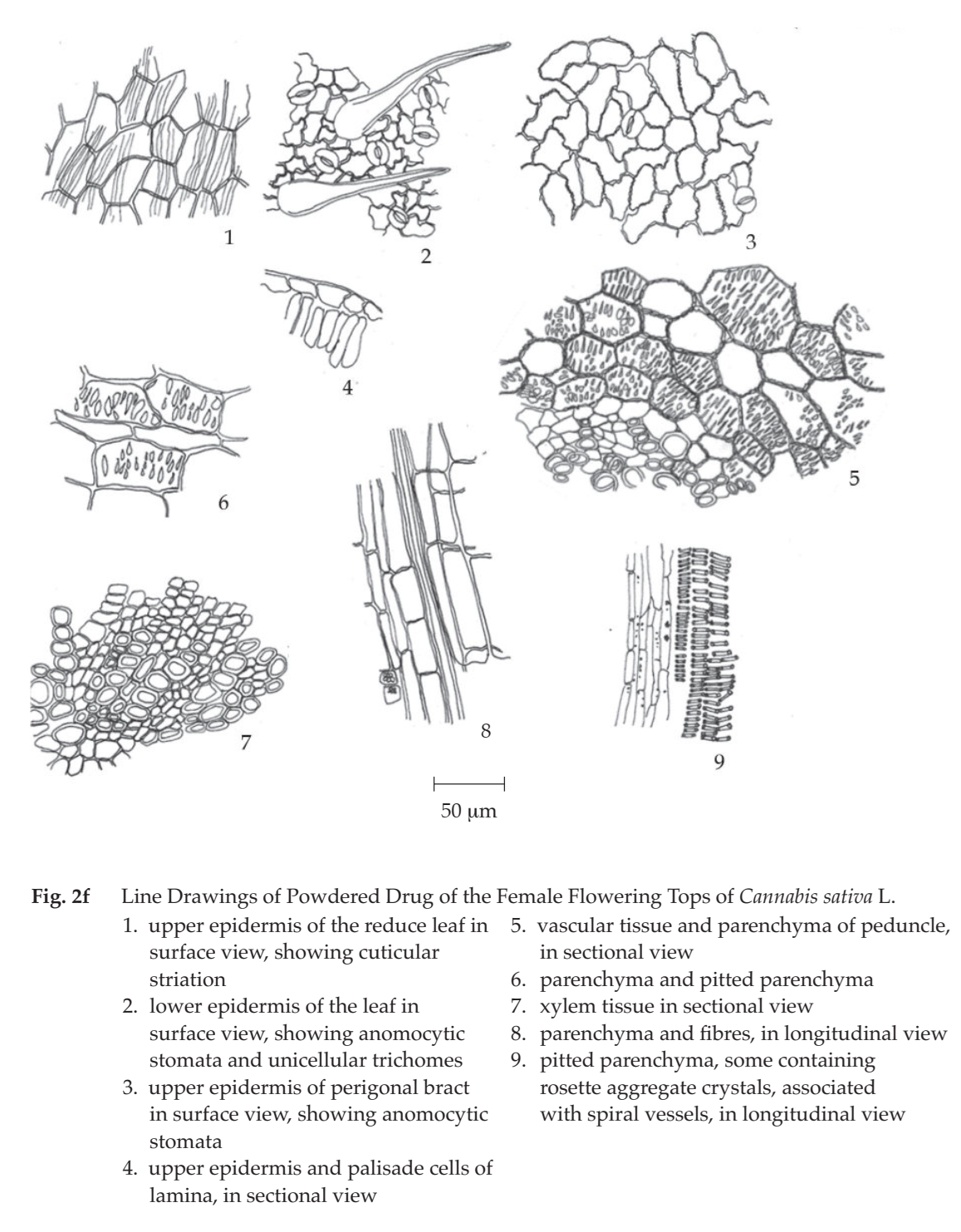
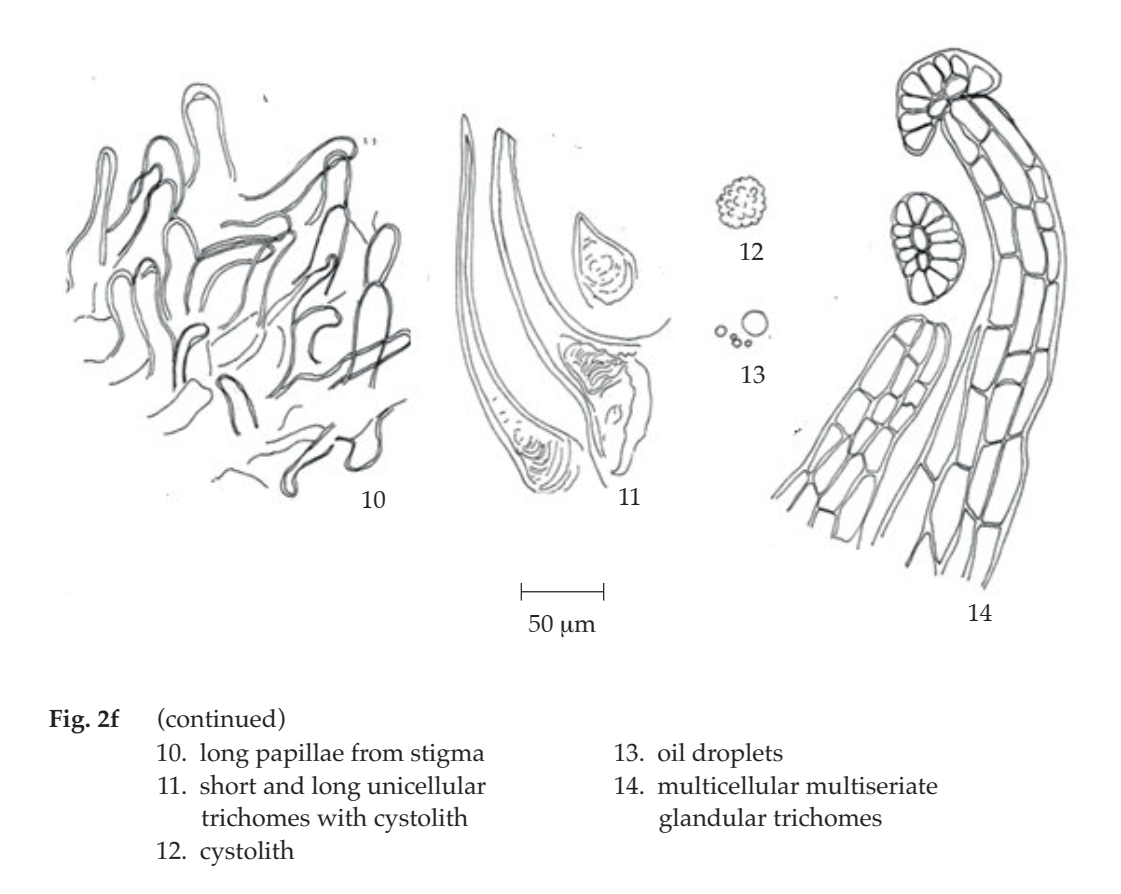
In surface view, the lamina shows upper epidermis, slightly rectangular cells with striation, unicellular trichomes with cystolith and cicatrices; lower epidermis, slightly wavy rectangular cells, anomocytic stomata, unicellular trichomes some containing cystolith, multicellular glandular trichomes with short stalk, and multicellular multiseriate glandular trichomes.
Transverse section of the peduncle of the female inflorescence shows epidermis, cortex, vascular tissue, and pith. Epidermis: a layer of rectangular cells, covered with cuticle layer; unicellular trichomes, some containing cystolith; multicellular glandular trichomes. Cortex: collenchyma, annular; parenchyma, some containing brown substance or rosette aggregate crystals. Vascular tissue: collateral vascular bundles, phloem and xylem; group of fibres.
Pith: parenchyma with pitted-walled and thin-walled parenchyma, some containing rosette aggregate crystals.
Transverse section of the perigonal bract of the female inflorescence shows upper epidermis, mesophyll, vascular tissue, and lower epidermis. Upper epidermis: a layer of rectangular cells, unicellular trichomes, and stomata. Mesophyll: parenchyma, some containing rosette aggregate crystals. Vascular tissue: phloem and xylem. Lower epidermis: a layer of rectangular cells, unicellular trichomes, and multicellular multiseriate glandular trichomes.
In surface view, the perigonal bract shows slightly wavy upper epidermal cells, anomocytic stomata, and unicellular trichomes; lower epidermis, varying in size and shape some with brown substance, anomocytic stomata, cicatrices, multicellular glandular trichomes, multicellular multiseriate glandular trichomes.
Hemp Female Flower in powder possesses the diagnostic microscopical characters of the unground drug. Unicellular trichomes and multicellular multiseriate glandular trichomes can be seen in abundance. However, unicellular trichomes with cystolith, together with glandular trichomes, are unique. Long papillae of stigma, and various-sized lower epidermis of perigonal bracts are found.
Additional information The two major cannabinoids found in Hemp Female Flower,
Δ9-tetrahydrocannabinol (Δ9-THC or THC) and cannabidiol (CBD), are initially produced by Hemp Female Flower in their carboxylic acid forms which are Δ9-tetrahydrocannabinoli acid (THCA) and cannabidiolic acid (CBDA), respectively, before converted into Δ9-THC and CBD by heating, light, or natural degradation, through decarboxylation process.
Packaging and storage Hemp Female Flower shall be kept in well-closed containers protected from light, and stored in a cool and dry place.
Identification

Loss on drying Not more than 10.0 per cent w/w after drying at 105° to constant weight (Appendix 4.15).
Foreign matter Not more than 2.0 per cent w/w (Appendix 7.2).
Acid-insoluble ash Not more than 6.0 per cent w/w (Appendix 7.6).
Total ash Not more than 19.0 per cent w/w (Appendix 7.7).
Ethanol-soluble extractive Not less than 13.0 per cent w/w (Appendix 7.12).
Water-soluble extractive Not less than 21.0 per cent w/w (Appendix 7.12).
Cannabidiol and Tetrahydrocannabinol contents Not less than 3.0 per cent w/w of cannabidiol (C21H30O2) and not more than 0.4 per cent w/w of tetrahydrocannabinol (C21H30O2). Carry out the determination as described in the “Liquid Chromatography” (Appendix 3.5).
Mobile phase A Dissolve 3.153 g of ammonium formate in a 10 per cent v/v solution of acetonitrile and dilute with the same solvent to 1000.0 mL. Adjust with formic acid to a pH of 3.75±0.05.
Mobile phase B Prepare a 90 per cent v/v solution of acetonitrile.
Diluent Prepare a mixture of the equal volumes of acetonitrile and water.
Standard stock preparation A Use a solution containing 1 mg per mL of Tetrahydrocannabinol RS in ethanol (Lipomed® or equivalent is suitable.).
Standard stock preparation B Dissolve an accurately weighed quantity of Cannabidiol RS in Diluent to obtain a stock solution having a known concentration of about 1 mg per mL.
Internal standard preparation Dissolve an accurately weighed quantity of Diazepam RS in Diluent to obtain a stock solution having a known concentration of about 500 μg per mL. Dilute this solution with Diluent to obtain a solution having a final concentration of about 50 μg per mL.
Standard preparations Dilute Standard stock preparation A and Standard stock preparation B, quantitatively, and stepwise with Diluent to obtain five solutions having known concentrations of about 2, 25, 50, 75, and 100 μg each of tetrahydrocannabinol and cannabidiol per mL. Upon dilution, add sufficient amount of Internal standard preparation so that each final solution contains diazepam at a concentration of about 50 μg per mL.
System suitability preparation Dilute Standard stock preparation A and Standard stock preparation B, quantitatively, and stepwise with Diluent to obtain a solution having known concentrations of about 50 μg each of tetrahydrocannabinol and cannabidiol per mL. Upon dilution, add sufficient amount of Internal standard preparation so that each final solution contains diazepam at a concentration of about 50 μg per mL.
Sample preparation Transfer about 200 mg of Hemp Female Flower, in No. 250 powder, accurately weighed, to a screw-capped centrifuge tube, add 10 mL of a mixture of 9 volumes of methanol and 1 volume of chloroform, sonicate for 30 minutes, centrifuge at 4,000 rpm for 5 minutes and allow to cool to room temperature. Evaporate 200.0 μL of the supernatant to dryness under a fume hood. Dissolve the residue in 2.0 mL of Internal standard preparation, sonicate for 2 minutes, and filter through a polyvinylidene fluoride membrane having a 0.45-μm porosity.
(Note In case the concentrations of tetrahydrocannabinol and cannabidiol in the Sample preparation are not in the concentration ranges of standard curve, allow to adjust the volume of the filtrate taken for evaporation.)
Chromatographic system The chromatographic procedure may be carried out using (a) a stainless steel column (15 cm × 4.6 mm) packed with octadecylsilane chemically bonded to porous silica or ceramic microparticles (3.5 μm), equipped with a similarly packed guard column (5 mm × 3.9 mm) and maintained at a temperature of 30°±1°, (b) Mobile phase at a flow rate of about 1.0 mL per minute (Note Make adjustments, if necessary to obtain the relative retention times of 0.2 for diazepam, 0.6 for cannabidiol and 1.0 for tetrahydrocannabinol), and (c) an ultraviolet photometer set at 228 nm.
The step gradient of mobile phases is as follows:

To determine the suitability of the chromatographic system, chromatograph System suitability preparation, and record the peak response as directed under Procedure and Calculation: the relative standard deviation for replicate injections is not more than 2.0 per cent.
Procedure Separately inject about 30 μL each of Standard preparations into the chromatograph, record the chromatograms and measure the responses for cannabidiol and tetrahydrocannabinol peaks. Plot the readings and draw the standard curve of best fit: the curve shows the correlation coefficient of not less than 0.999. Inject about 30 μL of Sample preparation into the chromatograph, record the chromatogram and measure the responses for cannabidiol and tetrahydrocannabinol peaks.
Calculation By reference to the standard curve, calculate the content of cannabidiol (C21H30O2) and tetrahydrocannabinol (C21H30O2) in the portion of the Hemp Female Flower taken.
